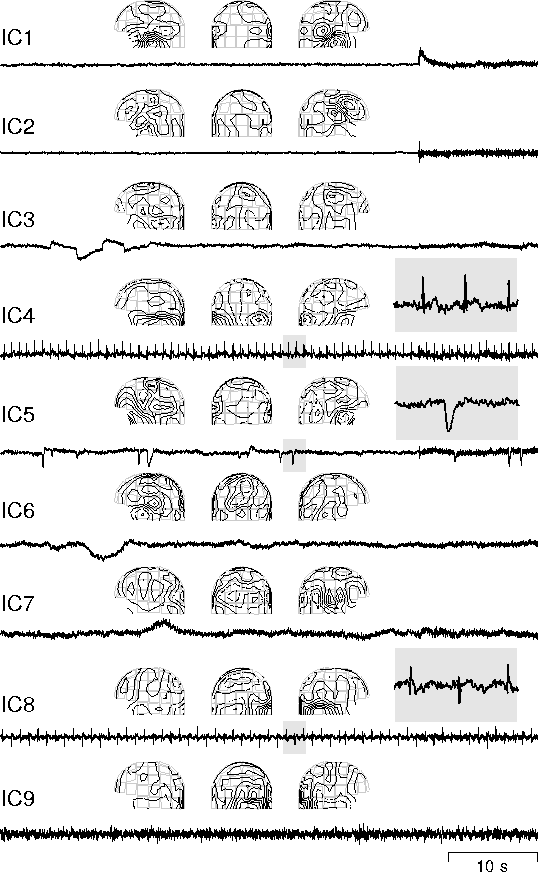


Next: Discussion
Up: Independent Component Analysis for
Previous: Methods
Figure ![[*]](cross_ref_motif.gif) shows sections of 9 independent components (IC's)
found from the recorded data, corresponding to a 1 min period, starting
1 min after the beginning of the measurements. The first two IC's,
with a broad band spectrum, are clearly due to the musclular activity
originated from the biting. Their separation into two
components seems to correspond, on the basis of the field patterns, to
two different sets of muscles that
were activated during the process. IC3 and IC5 are, respectively
showing the horizontal eye movements and the eye blinks, respectively.
IC4 represents cardiac artifact that is very clearly extracted. In
agreement with jousmaki, the magnetic
field pattern of IC4 shows some predominance on the left.
shows sections of 9 independent components (IC's)
found from the recorded data, corresponding to a 1 min period, starting
1 min after the beginning of the measurements. The first two IC's,
with a broad band spectrum, are clearly due to the musclular activity
originated from the biting. Their separation into two
components seems to correspond, on the basis of the field patterns, to
two different sets of muscles that
were activated during the process. IC3 and IC5 are, respectively
showing the horizontal eye movements and the eye blinks, respectively.
IC4 represents cardiac artifact that is very clearly extracted. In
agreement with jousmaki, the magnetic
field pattern of IC4 shows some predominance on the left.
The breathing artifact was visible in several independent
components, e.g. IC6 and IC7. It is possible that, in each breathing
the relative position and orientation of the metallic piece with
respect to the magnetometer has changed. Therefore, the breathing
artifact would be associated with more than one column of the mixing
matrix A, or to a time varying mixing vector.
Figure:
Nine independent components found from the MEG data. For
each component the left, back and right views of the field patterns
generated by these components are shown -- full line stands for
magnetic flux coming out from the head, and dotted line the flux
inwards.
 |
To make the analysis less sensible to the breathing artifact, and to
find the
remaining artifacts, the data were high-pass
filtered, with cutoff frequency at 1 Hz. Next, the
independent component IC8 was found. It shows clearly
the artifact originated at the digital watch, located to the
right side of the magnetometer.
The last independent component shown, relating to the first minute
of the measurement, shows an independent component that is related to
a sensor presenting higher RMS (root mean squared) noise than the
others.



Next: Discussion
Up: Independent Component Analysis for
Previous: Methods
Ricardo Vigario
3/3/1998
![[*]](cross_ref_motif.gif) shows sections of 9 independent components (IC's)
found from the recorded data, corresponding to a 1 min period, starting
1 min after the beginning of the measurements. The first two IC's,
with a broad band spectrum, are clearly due to the musclular activity
originated from the biting. Their separation into two
components seems to correspond, on the basis of the field patterns, to
two different sets of muscles that
were activated during the process. IC3 and IC5 are, respectively
showing the horizontal eye movements and the eye blinks, respectively.
IC4 represents cardiac artifact that is very clearly extracted. In
agreement with jousmaki, the magnetic
field pattern of IC4 shows some predominance on the left.
shows sections of 9 independent components (IC's)
found from the recorded data, corresponding to a 1 min period, starting
1 min after the beginning of the measurements. The first two IC's,
with a broad band spectrum, are clearly due to the musclular activity
originated from the biting. Their separation into two
components seems to correspond, on the basis of the field patterns, to
two different sets of muscles that
were activated during the process. IC3 and IC5 are, respectively
showing the horizontal eye movements and the eye blinks, respectively.
IC4 represents cardiac artifact that is very clearly extracted. In
agreement with jousmaki, the magnetic
field pattern of IC4 shows some predominance on the left.
